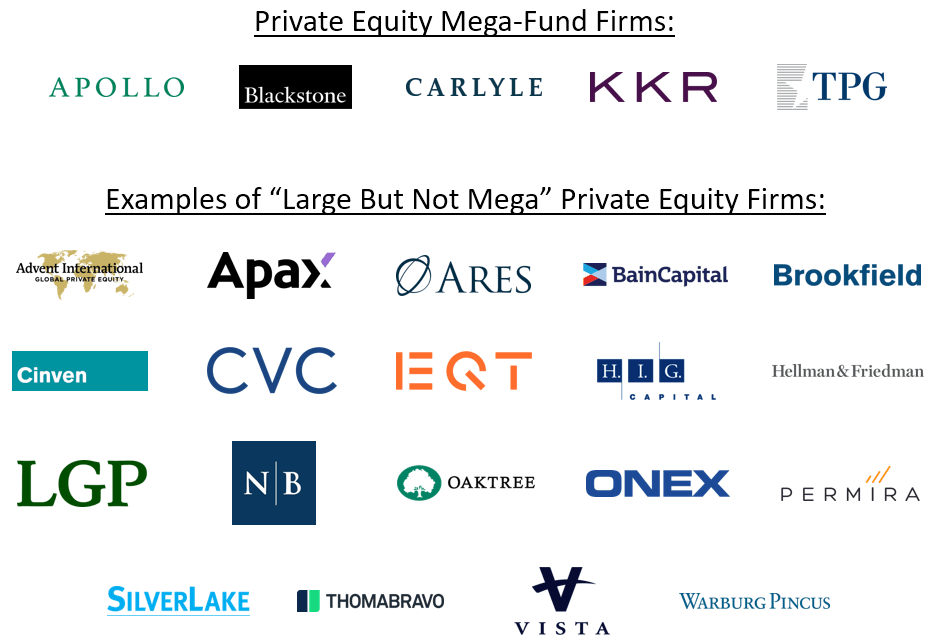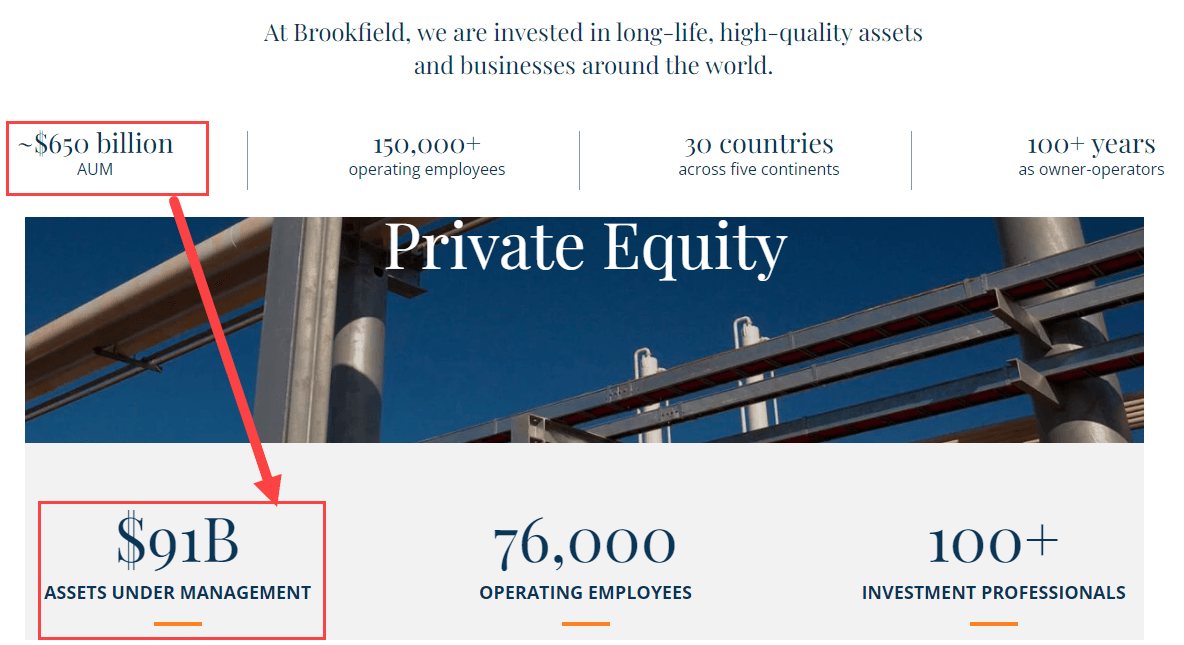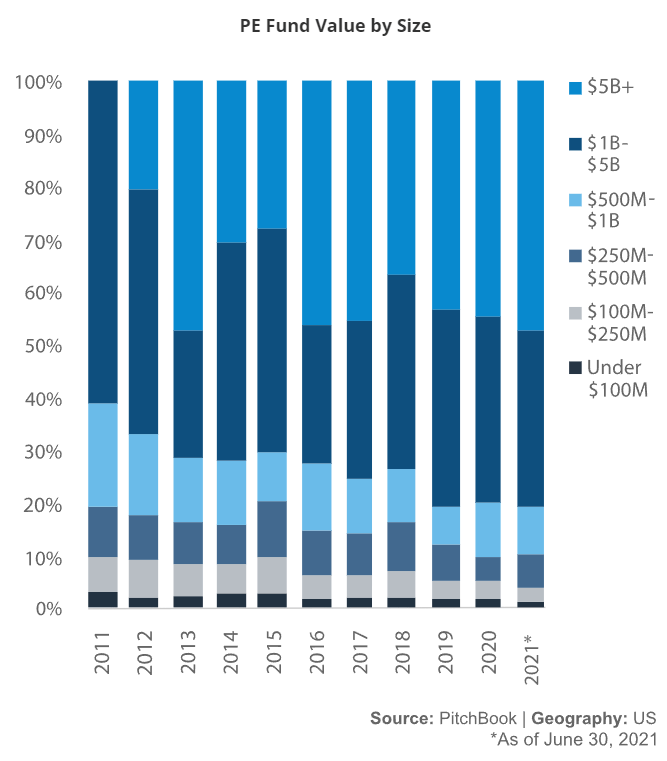Private Equity Mega-Funds: The Best of the Best?

Ask the average student or professional in the finance industry about their long-term career goal, and they’ll usually say, “private equity mega-funds.”
Of course, they may not phrase it exactly like that.
They might just mention the names of some large firms, such as KKR or Blackstone, and say that they’ve been dreaming about them since the age of 5.
Similar to middle market private equity, though, there are some definitional problems here.
Everyone agrees on the biggest private equity firms by assets under management (AUM), but what is the cutoff point to qualify as “mega”?
Should you use the total AUM or the 5-year fundraising total? What about the average deal size?
Are there just 4-5 mega-funds, or is it more like 10, 15, or 20?
How diversified should the firm be?
I don’t have all the answers, but I’m going to present them in this highly professional diagram anyway:

There are many other “large firms”; this list is representative, not comprehensive.
And yes, I realize Brookfield acquired a majority stake in Oaktree, but Oaktree still operates independently, so I am listing both firms.
Definitions: What is a Private Equity Mega-Fund?
There are a few components to a PE firm’s classification:
Private Equity Mega-Fund Definition: The “mega-fund” PE firms tend to have ~$100 billion or more in assets under management (AUM) and individual fund sizes of $10-15+ billion, and they execute deals with an average size of $1+ billion; these firms are also highly diversified in terms of geographies, industries, asset classes, and investment strategies.
Many sources online state that a “mega-fund” is one with at least $5 billion in it.
But this is not that helpful because when most people use the word “mega-fund,” they refer to entire firms rather than individual funds at a firm.
I set $1 billion as the average deal size here, but you’ll see many deals worth $5+ billion, $10+ billion, or even $20+ billion, depending on the market environment.
You might wonder why certain firms with significantly more than $100 billion in AUM, such as Brookfield in Canada or Ares in the U.S., are shown as “large but not mega” PE firms.
In both cases, it’s because they focus on areas outside of corporate private equity.
For example, Brookfield has $650+ billion in AUM, but most of it is allocated to real estate, credit, and infrastructure.
Less than $100 billion is allocated to private equity, so it’s not the firm’s main focus:

Similarly, Ares focuses on credit rather than traditional private equity, so it doesn’t qualify as an official mega-fund:

On the other hand, firms such as Thoma Bravo and Silver Lake are “almost big enough” to qualify as mega-funds, but they focus on specific industries, such as technology or TMT, making them less diversified than the likes of KKR or Blackstone.
Most mega-funds have these qualities in common:
- Geography: These firms operate globally and deal with globally diversified companies and assets.
- Asset Classes: Most firms operate across private equity, real estate, credit, infrastructure, and other areas, even if they focus on traditional (corporate) PE.
- Deal Types: Deals rely heavily on “financial engineering,” or using complex debt and equity instruments to boost returns. There may be operational improvements and platform strategies, but deals tend to rely on leverage.
- Company Types: These firms invest in large, publicly traded companies that serve addressable markets worth tens or hundreds of billions.
- Recruiting: If you don’t work in one of the top groups at a bulge bracket bank (or an elite boutique), you don’t have much of a chance at these firms. Recruiting is fast, highly structured, and open only to select candidates.
While PE mega-funds have always been the giants of the industry, they’ve taken on special importance over the past decade because funds keep getting bigger:

It’s not even that rare to raise a $5 billion fund anymore; to be cool, you need at least $20-30 billion.
“Large Firms” vs. Private Equity Mega-Funds
Before moving on, it’s also worth addressing firms that are “large but not mega.”
Examples include Silver Lake, Thoma Bravo, Ares, CVC, EQT, Vista, Hellman & Friedman, and plenty of others from the logos above.
The recruiting process and day-to-day work at these firms are similar to mega-funds.
Expect to work long hours on large deals, and as a junior person, expect to do a lot of financial modeling and due diligence and not much else.
The difference is that many of these firms specialize in a specific strategy, industry, or asset class, and they are open to a broader pool of candidates.
For example, if you’ve worked in a good industry group at a bulge bracket bank, you could recruit for these firms.
You don’t necessarily need to be in “the bestest group ever” to have a good shot.
And if you’ve been a consultant at one of the top three firms (MBB), you might have a chance at one of the PE firms known for hiring consultants, such as Golden Gate Capital.
Mega-Funds vs. Middle Market Private Equity
We discussed these differences in the article on middle market private equity, so please refer to that for a detailed comparison.
In short: MM PE firms do smaller deals ($50 – $500 million), they raise smaller individual funds, they’re less diversified, compensation is lower, recruiting is slower and more off-cycle, and deals often focus on operational improvements rather than financial engineering.
The skill set is also quite different, especially as you move up to the mid-level and beyond.
Since you’re dealing with smaller, often family-owned businesses, you need to be much better at connecting with owners and operators and convincing them to work with you.
Communication/negotiation abilities are still important at the mega-funds, but the context is different since major company decisions depend on the Board or a shareholder vote.
How to Recruit at the Private Equity Mega-Funds
The on-cycle recruiting process here is fast and unforgiving, at least in the U.S. (in other regions, the process often starts later and moves more slowly).
We published an article about this process a few years ago; not much has changed, but the timing may differ due to the continued pandemic disruptions.
The main points are:
- Qualifying: Recruiters will reach out to you based on your bank, group, and university, and you can’t do much to tilt the odds in your favor. Traditional “networking” for these roles doesn’t work unless a spot opens up later on because someone drops out. You might be a great candidate, but the selection is based on brand-name recognition.
- Evaluations: Since this process starts so early, firms judge you mostly based on technical questions, LBO modeling tests, and standard fit/behavioral questions. You’re unlikely to have much deal experience, but you can always try to spin pitches and early-stage deals into sounding more significant.
- Practicing: Besides spinning your deals, all you can do to become more competitive is practice many timed LBO modeling tests and review the technical questions.
Occasionally, off-cycle spots at these firms open up, in which case you can certainly apply.
But even that is quite random, and you still don’t have a great chance if you’re not in one of the top groups.
Why Work at a Private Equity Mega-Fund?
The biggest advantages of the PE mega-funds are:
- Compensation: You earn more across all levels than you would at a middle market or boutique firm. Depending on the market and specific comparison, the difference could be anywhere from 20% to 50%. And firms like Apollo are known for paying well above market rates, such as offering $500K+ to Year 1 Associates (!) if you include “retention bonuses.”
- Deal Complexity / Technical Skills: You’ll get more experience building models, completing due diligence, and working on deals with complex capital structures at these firms.
- Exposure to Different Strategies, Asset Classes, and Industries: You’ll initially work across industries, and if you decide you want to do credit, real estate, or infrastructure rather than traditional PE, you can always switch teams.
- Brand Name / Reputation: Finally, these firms are very well-known within the finance industry, so they offer better exit opportunities than smaller PE firms. They’re not as well-known as the bulge bracket banks outside of finance, but plenty of connected figures within political circles and big companies know them.
Why Not Work at a Private Equity Mega-Fund?
On the other hand, there are also downsides that explain why not everyone wants to join the mega-funds:
- Autonomy: In many ways, it’s Banking 2.0: you’ll follow the orders of mid-level staffers and crank away in Excel and PowerPoint and data rooms. You’re not going to lead deal teams until you become much more senior.
- Work Hours / Lifestyle: Expect the same hours as investment banking, or even worse in some cases (!). You will not have a life until you become significantly more senior or switch to a smaller firm.
- Advancement: Few Associates at these firms get promoted to the VP level, so many go to business school or seek other exit opportunities. Even if you do get promoted, it’s difficult and time-consuming to reach the top because these firms are fairly crowded in the mid-to-top levels.
- Returns Potential and Asset Diversification: Although performance stats such as IRR don’t necessarily differ much by fund size, it is more difficult to earn outstanding results at large firms because it’s challenging to find big, mis-priced assets. Also, the diversification of these firms could work against you if the CEO shifts the firm’s focus and hiring efforts to other areas.
- Accessibility: Finally, as discussed above, your chances at these firms aren’t great unless you’re in one of the top groups in all of investment banking.
How A Day in the Life Differs at the Large Firms
Our PE Analyst and PE Associate articles assume mid-sized firms.
At the mega-funds and other large PE firms, expect more number-crunching, less “coordination,” and longer hours with more last-minute requests.
So, combine these accounts with the IB Analyst one and up the stakes and stress levels to get a flavor of the environment.
Mega-Conclusions on the Private Equity Mega-Funds
I’ve summarized the main advantages and disadvantages of PE mega-funds above, so I’ll address two other questions at the end:
- Why are so many people obsessed with these large PE firms?
- Will these firms always be seen as the most desirable places to work in the finance industry?
With the first question, the answer is that most people don’t know what they want to do.
This is especially the case in private schools, elite universities, and MBA programs, where students “decide on” their career goals by copying everyone else.
And, surprise, surprise, that leads to everyone going into finance or consulting (though tech has been gaining on them).
If you don’t know what you want to do, but you’re willing to work like crazy for years, you are a good fit for the private equity mega-funds.
It’s the “default” thing to do, and these firms have been building their reputations for decades to attract these types of people.
As for whether these firms’ reputations will last, I’ve been skeptical of the entire private equity industry over the past few years.
The industry benefited from zero-to-negative interest rates, money printing, and fiscal and regulatory policies that disproportionately benefited the wealthy – and these mega-funds reaped the biggest gains.
I don’t think these large firms will “disappear,” but I do think that some of the policies that enabled their rise will reverse or normalize in the future.
When that happens, the private equity mega-funds will still be there grinding away – but they might not seem quite as shiny as they once did.
Further Reading
You might be interested in The Full Guide to Direct Lending: Industry, Companies & Careers or Negative Interest Rates, Negative Yields, and the Next Financial Crisis.
Free Exclusive Report: 57-page guide with the action plan you need to break into investment banking - how to tell your story, network, craft a winning resume, and dominate your interviews
Comments
Read below or Add a comment




Hi Brian,
Finding your site extremely informative.
I’m late 20’s now and have about 3 years work experience working in the operational team as the Agent, administering the loans between Direct Lending/Private Equity firms and the borrower. We work with a lot of the firms mentioned in this article. I’m UK based and my uni grades weren’t great (young and naive at the time!).
What do you think the realistic chances are for me to make the switch to a PE or DL firm?
Thanks
I think it will be quite difficult if you’re in more of a middle or back office role. If you want to do this, you’ll probably have to go smaller (boutique or regional firm) and find a role where your borrower relationships might be helpful. It’s generally pretty difficult to move from MO/BO roles to the front office in most areas of finance.
Great article, thanks a ton.
I am at HYP and have a mid tier BB internship this summer (think Citi or BofA). I was placed into a lower tier industry group (both low at the bank and low on the street), and I am really hoping to switch into a product group for full-time to exit to megafund PE. Do you think it’s worth applying to other banks? How easily can people switch to high-demand groups after receiving a return offer? Or do you have general advice on this matter?
No. You’re splitting hairs. Focus on performing well, getting a return offer, and interviewing successfully. By the time you win a PE offer or start in the role, you may not even want to do it anymore. “Prestige” seems important when you’re in university but becomes irrelevant after a few years.
Hey Brian, what do you think it takes to get a job at one of the megafunds right out of undergrad? I’m a rising sophomore athlete at HYP with a 4.0, stats & data science major, doing a PE internship (MM) this summer. What advice would you have for me in targeting one of these for my junior year internship? Also, any recommendations for an internship I could pursue for next summer (after my sophomore year) that may help? Should I target another PE internship? Thanks, very much appreciate all of the posts / advice.
It’s the same criteria you would need to get into the top EB/BB banks because the same types of people recruit for both roles: high GPA, top university, previous internships, good technical knowledge/deal experience, ability to talk to other humans without staring at your phone, etc. If you want to work at one of these funds, focus on summer internships at them because they will mostly hire summer interns for full-time roles. But you should also consider whether it’s in your best interest because going to a large bank after university still gives you broader options.
This is an amazing article
Thanks!
Thanks very much Brian, very insightful as usual.
Any thoughts on Private Credit? I’ve generally seen this asset class gain traction with however less “hype” from students than PE. Any ideas on hours/comp e.g. in EU? How difficult is it to break in from a current M&A role?
Thanks
Thanks. Yes, private credit is somewhat overlooked. We did cover direct lending careers here: https://mergersandinquisitions.com/direct-lending/
Compensation is definitely lower than in traditional PE, but there may not be as wide a gap at the mega-funds / other large firms. You could probably get in from a current M&A role, assuming you have at least some exposure to debt-funded deals.